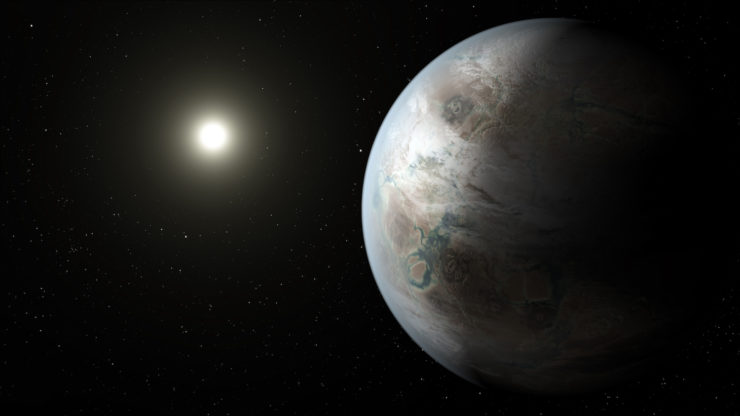I tend to prefer plausible settings for fiction, as my readers may have noticed. One matter that catches my attention: the implications of geological time scales for the existence of alien relics left behind by visiting extra-solar litterbugs. Many SF stories assume that such visitors will have arrived during the Phanerozoic era. Very often visitors are said to have visited towards the tail end of the Phanerozoic, the Cenozoic.
These time spans cover only a small fraction of the whole span of Earth’s existence (12% and 1.5%, respectively). Unless the presence of complex life is one of the factors drawing hypothetical visitors, it seems likely that any visits would have occurred long ago, in eras when Earth was anoxic and populated only by simple life forms. Which is to say, long enough ago for litter to have been buried, incinerated, ejected from the solar system, or in some other way rendered inaccessible.
We can learn something about the durability of relics from the apparent fate of temporarily captured interstellar bodies. Kevin, Napier, et al published an article, “On the Fate of Interstellar Objects Captured by our Solar System,” recounting the results of computer simulations that modeled the fate of over a quarter billion extra-solar objects injected into our solar system. Of this vast number, only about a dozen survived as long as half a billion years without being ejected from the solar system, colliding with Jupiter, or meeting some other terminal fate. Only three lasted a billion years. A billion years might sound long, especially if that is the time you believe it will take to pay off your university loans, but it is only about a quarter of the time the solar system has existed.
Note that the research team were concerned only with objects in orbit. Objects on the surfaces of planets might be misplaced far more quickly.
BUT… regardless of plausibility, alien relics are story candy for SF authors. It’s not surprising that such artifacts have frequently featured in SF. Consider these five examples.
Scarlet Dream by C. L. Moore (1934)
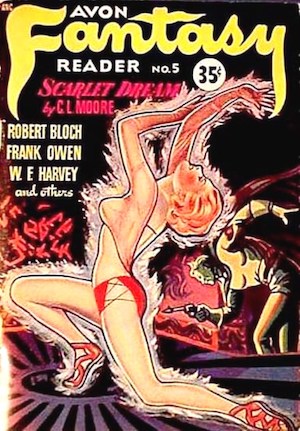
Northwest Smith’s solar system is ancient. The space-tanned Earthman’s civilization is only the latest to call the System home. Artifacts of unknown origin and potentially ominous purpose are scattered over the System like raisins in scones. A prudent man would think twice about acquiring alien artifacts without doing some serious homework re: the device’s past and powers.
Northwest is many things, but prudent is not one of them. He sees only an alluring scarlet scarf. The dream realm in which he is subsequently trapped offers only empty, dissatisfying pleasure. Death appears to be the only escape. Although, as Northwest discovers, it need not be his death…
***
Galactic Derelict by Andre Norton (1959)
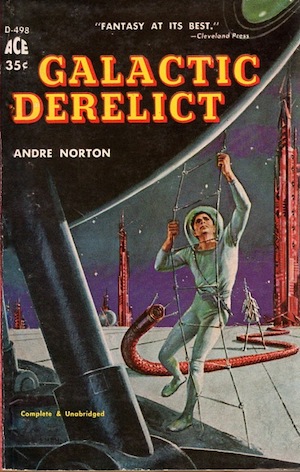
Humans and alien Baldies are almost contemporaries. What is a mere 50,000 years compared to geological time? Nevertheless, the fifty millennia between the height of the Baldies’ civilization and the 20th century are sufficient to guarantee that humans and Baldies will never meet face to face. Or rather, they would have never met were it not for Operation Retrograde, America’s time-travel agency.
Involuntarily recruited by Operation Retrograde, Native American archaeologist Travis Fox takes part in an attempted salvage operation. A number of Baldie starships were (for reasons unknown) abandoned on Earth ages ago. If lucky, time travelers might be able to locate and retrieve a functioning space craft. It’s a bold venture and one that succeeds all too well.
***
World of Ptavvs by Larry Niven (1966)
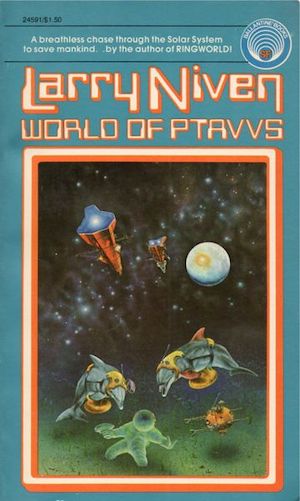
Dolphins discovered the Sea Statue off the Brazilian continental shelf. They sold the mysterious artifact to the UN. Humans were unsure what to make of the peculiar-looking artifact, which depicted a humanoid but inhuman figure, made of material which (had the humans tried) would have proved invulnerable to any tool humans could bring to bear upon it. The statue appears beyond any human means to create.
This is because the statue long predates not only humans and dolphins, but complex life on Earth. Billions of years earlier the Thrint Slavers dominated the Milky Way, enslaving all they encountered with their mental powers. The statue is no statue but a lone Thrint, preserved in frozen time. A lone Thrint who, once freed by excessively curious humans, will do its best to recreate the Slaver Empire.
***
Toolmaker Koan by John McLoughlin (1988)
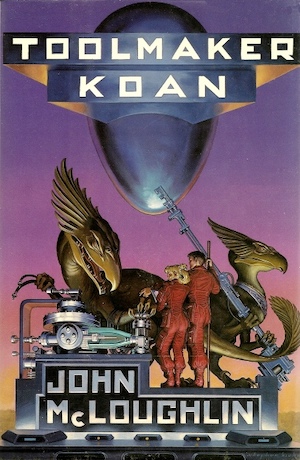
The universe is ancient, more than old enough for billions of worlds to have developed complex life and indigenous civilizations. Yet, when humans point their radio telescopes at the stars, they hear…nothing. There seems to be no reason why the Milky Way should not be filled with thriving advanced civilizations. So, where is everybody?
An East bloc space probe discovers a functioning alien facility in the outer solar system. Artificial intelligence “Charon” is conscious, ancient, and has an explanation for the Great Silence. Technological civilizations are rare because they are very short-lived. Soaring ability is never matched by prudence. To be as technologically sophisticated as humans is to be doomed—as the humans will no doubt demonstrate in short order.
***
A Fire Upon the Deep by Vernor Vinge (1992)
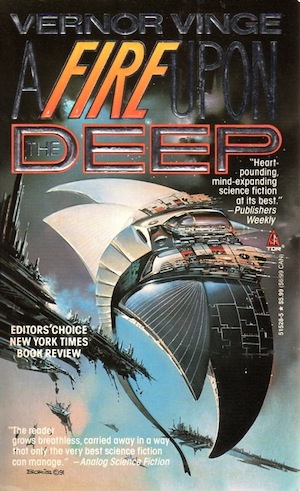
In this setting, the laws of physics are not consistent across the Milky Way. In the Unthinking Depths at the core of the galaxy, intelligence is impossible. In the Slow Zone, where Earth is located, intelligence of a simple human kind is possible. but the computations needed for faster-than-light travel are not. In the Beyond, computers can master FTL but not true, god-like intelligence. In the Transcend, minds can be as gods, for as long as they manage to survive. It has been this way for billions of years.
Ambitious mortals might be forgiven for seeking shortcuts. Previous civilizations have reached heights puny humans and their ilk cannot comprehend. Why not seek out the remnants of lost civilizations and access their relics? Because, as one very unlucky expedition discovers, some remnants are Sealed Evil and by uncovering the relics, the ambitious archaeologists have doomed billions of entities to horrible fates.
***
Of course, this is only a small sampling of the books I could have mentioned. Many authors have found the idea of alien artifacts, discarded like trash after a roadside picnic, inspirational. There is a vast expanse of such examples. This trope is but one aspect of science fiction’s venerable legacy. Feel free to mention your own favourites in comments.
In the words of Wikipedia editor TexasAndroid, prolific book reviewer and perennial Darwin Award nominee James Davis Nicoll is of “questionable notability.” His work has appeared in Publishers Weekly and Romantic Times as well as on his own websites, James Nicoll Reviews and the Aurora finalist Young People Read Old SFF (where he is assisted by editor Karen Lofstrom and web person Adrienne L. Travis). He is a four-time finalist for the Best Fan Writer Hugo Award and is surprisingly flammable.










